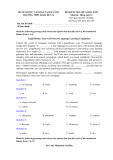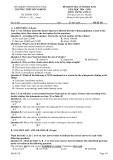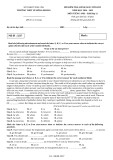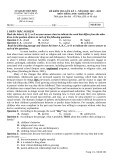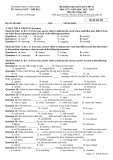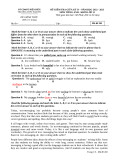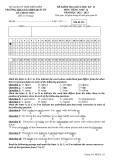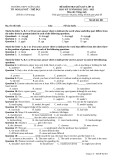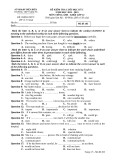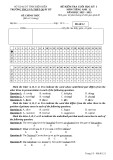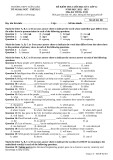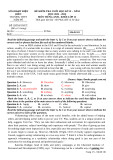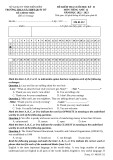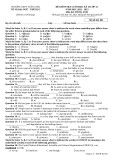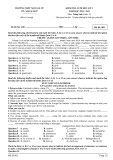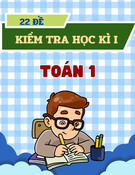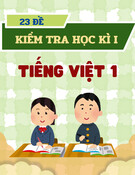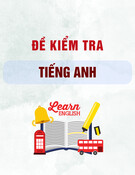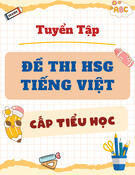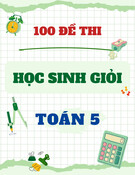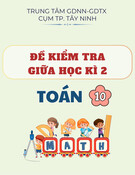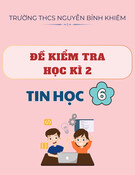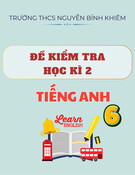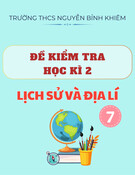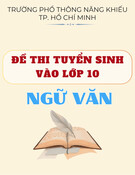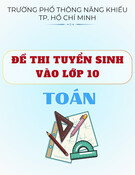Ỳ Ớ Ở S GD&ĐT VĨNH PHÚC ƯỜ Ự ế NG THPT NGÔ GIA T TR
ờ ề ể ờ ệ ề ắ ồ Ọ K THI KSCĐ L P 12. NĂM H C 2016 2017 Môn thi: Ti ng Anh Th i gian làm bài 60 phút, không k th i gian giao đ (Đ thi g m 60 câu tr c nghi m)
ề Mã đ : 271
ọ
SBD: ………………… H và tên thí sinh: ………………………………………………………………..
Mark the letter A, B, C, or D on your answer sheet to indicate the word whose underlined part differs from the other three in pronunciation in each of the following questions. Câu 1: A. switch Câu 2: A. mastered D. character D. dedicated C. christmas C. gifted B. chemical B. minded
Mark the letter A, B, C, or D on your answer sheet to indicate the word whose stress differs from the other three in pronunciation in each of the following questions. Câu 3: A. sacrifice Câu 4: A. security Câu 5: A. decoration C. visit C. obedient C. conservation B. approval B. candidate B. information D. physical D. attendance D. location
Mark the letter A, B, C, or D on your answer sheet to indicate the correct answer to each of the following questions. Câu 6: Joe promised us he would finish by the .............. day D tomorrow B. before
A. previous C. next
Câu 7: Not until late 1960s…….on the moon.
A. when Americans walked C. when did Americans walk B. that Americans walked D. did Americans walk
Câu 8: Is it necessary that I .............. here tomorrow?
A. would be B. were C. am being D. be
Câu 9: My new glasses cost me .............. the last pair that I bought last month. B. more than three times D. as much three times as A. more three times than C. three times as much as
Câu 10: The train was ________ by a heavy snowfall.
A. held up B. held out C. held back D. held off
Câu 11: His answer was so confused that I could hardly make any .............. of it at all
A. sense B. meaning C. intelligibility D. interpretation
Câu 12: Hurry up! They have only got .............. seats left.
A. a lot of B. a few C. a little D. plenty of
Câu 13: During the starvation, we used to keep a .............. of dried food in the factory.
A. conserve B. reserve C. substitute D. preserve
Câu 14: Harry’s new jacket doesn’t seem to fit him very well. He __ it on before he bought it.
A. needn’t have tried D. must have tried
C. should have tried B. might have tried Câu 15: I'm .............. you liked the film. I thought it was rather ...............
ề
Trang 1/5 Mã đ thi 271
A. surprise / disappoint C. surprised / disappointed
B. surprised / disappointing D. surprising / disappointed Câu 16: Ann: "Can I help you, Sir?" Man: " I'm looking for a .............. table."
A. fashionable round wooden C. wooden round fashionable B. wooden fashionable round D. round wooden fashionable
Câu 17: I had to get up early, ………I’d have missed the train. B. but A. if not C. otherwise D. so that
Câu 18: Thank you for your compliment .............. my achievements.
A. on B. with C. to D. from
Câu 19: He tends to forget things very quickly and behaves more and more like the typical……..professor A. clearminded B. absentminded D. coolminded C. wellminded
Câu 20: The girls and flowers .............. he painted were vivid. B. that A. which C. who D. whose
“..............” Câu 21: “My parents got divorced when I was 5.”
A. They shouldn’t do that. C. Oh, I’m sorry.
B. You must have been shocked D. How did it happen? Câu 22: I have not found the book .............. our teacher advised us to read.
A. whom B. when C. who D. which
Mark the letter A, B, C or D to indicate the word or phrase that is CLOSEST in meaning to the
italic part in each of the following questions. Câu 23: In rural Midwestern towns of the USA, the decisions that affect most residents are made at general assemblies in schools and churches.
A. concerts B. public libraries C. prayer services D. gatherings
Câu 24: Each year about fifty hundred species of plants and animals are already being eliminated.
A. removed B. tossed C. kicked D. dropped
Mark the letter A, B, C or D on your answer sheet to indicate the word or phrase that is OPPOSITE
in meaning to the underlined part in each of the following questions. Câu 25: We'd better speed up if we want to get there in time.
A. put down C. lie down D. turn down
B. slow down Câu 26: We didn't plan to meet each other. We just met accidentally. B. coincidently A. simultanously C. hurriedly D. intentionally
Read the following passage and mark the letter A, B, C or D on your answer sheet to indicate the
correct answer to each of the questions.
As Christmas evolved in the United States, new customs were adopted and many old ones were reworked. The legend of Santa Claus, for example, had origins in Europe and was brought by Dutch settlers to New York in the early 18th century. Traditionally, Santa Claus – from the Dutch Sinter Klaas – was depicted as a tall, dignified, religious figure riding a white horse through the air. Known as Saint Nicholas in Germany, he was usually accompanied by Black Peter, an elf who punished disobedient children. In North America he eventually developed into a fat, jolly old gentleman who had neither the religious attributes of Saint Nicholas nor the strict disciplinarian character of Black Peter.
Santa’s transformation began in 1823, when a New York newspaper published the poem A Visit from Saint Nicholas, which Clement Clark Moore had written to amuse his daughter. The poem introduced many Americans to the story of a kindly saint who flew over housetops in a reindeerdrawn sleigh.
ề
Trang 2/5 Mã đ thi 271
Portraits and drawings of Santa Claus by American illustrator Thomas Nast further strengthened the legend during the second half of the 19th century. Living at the North Pole and assisted by elves, the modern Santa produced and delivered toys to all good children. By the late 19th century he had become such a prominent figure of American folklore that in 1897, when Virginia O’Hanlon wrote to the New York Sun newspaper asking if Santa was real, she received a direct answer: “Yes, Virginia, there is a Santa Claus”.
Câu 27: Who brought the legend of Santa Claus to the USA according to the passage?
A. Dutch settlers B. Saint Nicholas C. A German D. Sinter Klaas
Câu 28: Santa Claus was traditionally described as a
A. religious figure C. tall man who could walk through the air B. fat, jolly, old man D. fat man riding a white horse
Câu 29: Santa Claus in North America was depicted as
A. a man with the strict disciplinarian character of Black Peter B. a good old man with less religious character C. a jolly man on horseback D. one with religious attributes of Saint Nicholas
Câu 30: Who was Black Peter? A. a popular traditional figure C. one of the disobedient children B. an elf accompanying Saint Nicholas D. an elf who rode a white horse
Câu 31: What word is closest in meaning to attributes?
A. natural qualities B. outer appearance C. effects D. symbols of a person
Câu 32: Where did the legend of Santa Claus come from?
A. the City of New York C. North America B. the North Pole D. Europe
Câu 33: 1823 was mentioned as a year when
A. Saint Nicholas visited New York B. Clement Clark Moore wrote his first poem C. the image of Santa Claus was transformed D. Clement Clark Moore’s poem made him popular
Câu 34: According to Clement Clark Moore’s poem
A. Santa Claus liked poetry B. Santa Claus had nothing different in appearance from the traditional one C. Santa Claus was a kindly saint who flew over housetops in a sleigh D. Santa Claus had wings and could fly
Câu 35: The answer Yes, Virginia, there is a Santa Claus is an illustration for the fact that
A. Virginia O’Hanlon was a reader of the New York Sun B. Santa Claus was a prominent figure at that time C. newspapers are unreliable D. the New York Sun was popular with children Câu 36: Which of the following statements is TRUE?
A. Santa Claus was an imaginary old man created by artists based on traditional figures B. Santa Claus was a real figure living in northern America C. Santa Claus was a story based on Saint Nicholas and Black Peter D. Living in the North Pole, Santa Claus visited children at Christmas
Mark the letter A, B, C or D on your answer sheet to show the underlined part that needs correction
from.
ề
Trang 3/5 Mã đ thi 271
s e t last night (B) be c a u se he (C) h a d t o d o too (D) m an y h o m e w o r ks .
Câu 37: Jim was (A) up
Câu 38: John lived (A) in New York (B) si n ce 1960 to 1975, but he (C) is n o w l i v i n g (D) i n Detroil. Câu 39: The mountain sheep (A) is know for its (B) incredible agility, (C) timid and ability (D) to withstand severe cold.
Câu 40: Rudolph Nureyev (A) ha s be c o m e one of the (B) gr ea t e st (C) d an c e r that the ballet world has (D) e v e r k no
w n.
Choose the word or phrase A, B, C or D that best completes the passage.
Today there are libraries in almost every towns in the world. Even in areas (41) there are no libraries, there are often mobile libraries which take boos from one village to (42). But in the days when books were copied by hand (43) than printed, libraries were very rare. The reason is simple: books took a very long time to produce, and there were far fewer copies of any given work around. The greatest library (44) all, that in Alexandria, had 54,000 books.
In the ancient world, this number (45) considered huge. It was the first time that anyone had collected so many books from all around the world (46) one roof. There are many theories about why these books were lost. (47) is that the library accidentally burned down. Another is that one of the rulers of the city ordered the books to be burned. They were taken to various places and it took six months to burn them. (48) happened, the collection there was priceless. Many of the library’s treasures were lost foreversome books were (49) recovered. We cannot even know (50) what the library contained.
Câu 41: A. the place Câu 42: A. others Câu 43: A. more Câu 44: A. in Câu 45: A. was Câu 46: A. below Câu 47: A. All Câu 48: A. whatever Câu 49: A. almost Câu 50: A. exactly B. who B. other B. much B. about B. is B. under B. None B. wherever B. never B. really C. which C. another C. rather C. over C. has been C. in C. A theory C. Whoever C. already C. detailedly D. where D. the other D. else D. of D. were place D. over D. One D. Whichever D. yet D. yet
Read the following passage and mark the letter A, B, C, or D on your answer sheet to indicate the correct answer to each of the questions.
Since water is the basic part of life. Composing the greatest part of the tissues of all living things, the crucial problem of desert animals is to survive in a world where sources of flowing water is rare. And since man’s inexorable necessity is to absorb large quantities of water at frequent intervals, he can scarcely comprehend that many creatures of the desert pass their entire lives without a single drop.
Uncompromising as it is, the desert has not eliminated life but only those forms unable to withstand its desiccating effects. No moistskinned, waterloving animals can exist there. Few large animals are found: the giant of the North American desert are deer, the coyote, and the bobcat. Since desert country is open, it holds more swiftfooted, running, and leaping creatures than the tangled forests. Its population is largely nocturnal, silent, filled with reticence, and ruled by stealth. Yet they are not emaciated. Having adapted to their austere environment, they are as healthy as animals anywhere in the world.
The secret of their adjustment lies in a combination of behavior and physiology. None could survive, if, like mad dogs and Englishmen, they went out in the midday sun, many would die in a matter of minutes. So most of them pass the burning hours asleep in cool, humid burrows underneath the ground,
ề
Trang 4/5 Mã đ thi 271
emerging to hunt only by night. The surface of the sunbaked desert averages around 150 degrees, but 18 inches down the temperature is only 60 degrees.
Câu 51: What is the topic of the passage?
A. Animal life B. Desert plants C. Desert life D. Forest life
Câu 52: The phrase “those forms” refers to all the following except ______
A. moistskinned animals C. waterloving animals B. the bobcat D. many large animals
Câu 53: The word “inexorable” is closest in meaning to _______ C. relentless A. indispensable B. demanding D. full
Câu 54: The author mentions all of the following as example of the behavior of desert animals except ____
A. animals are noisy and aggressive C. animals sleep during the day B. animals are watchful and quiet D. animals dig homes underground
Câu 55: The word “them” refers to _______
A. behavior and physiology C. desert animals B. minutes D. mad dogs and Englishmen
Câu 56: The word “emaciated” is closest in meaning to _______ B. cunning A. unmanageable C. wild D. unhealthy
Câu 57: The author states that one characteristic of animals living in the desert is hat they _______
A. are less healthy than animals living in different places B. can hunt in temperature of 150 degrees C. live in an accommodating environment D. are smaller and fleeter than forest animals
Câu 58: Which of the following generalizations is supported by the passage?
B. Healthy animals live longer lives
A. Water is the basis of life C. All living things adjust to their environments D. Desert life is colorful
Câu 59: The word “burrows” is closest in meaning to ________
A. underground houses B. underground holes C. underground nests D. underground caves
Câu 60: How is the temperature 18 inches underground compared to that on the surface in the desert?
A. half B. much higher C. the same D. less than half
Ế H T



